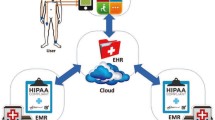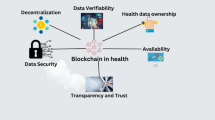Abstract
Healthcare has undergone a revolution from version 1.0 to version 4.0, with version 2.0 introducing electronic health records (EHRs) to replace the analysis ones and version 3.0 focusing more on patients. Telehealth, cloud computing, fog computing, the Internet of Things, and other IoT technologies share data across many healthcare parties, originally designed with the patient in mind. However, designing a secure method for Healthcare 4.0 has always been challenging. Hackers may be able to access patients’ email accounts, messages, and reports because of a security flaw in the healthcare system. In contrast, a trustworthy healthcare approach may meet the needs of both patients and medical professionals. Therefore, extra precautions must be taken while storing, accessing, and exchanging patient medical records in the cloud to prevent data breaches caused by legitimate E-healthcare system users. Several cryptographic techniques have been developed to make cloud-based medical records safe for sharing, accessing, and storing. However, traditional approaches to EHR security fell short in several key respects, such as computational efficiency, service-side verification, user-side verifications, and robust security—all without the need for a trusted third party. Strong security for data storage and sharing with minimal computational effort has drawn much interest recently, and here is where blockchain-based security solutions come in.Bitcoin technology was the blockchain’s primary focus among academics. Using the blockchain to manage healthcare records safely has become popular recently. The systematic analysis of current blockchain-based medical data security solutions, both with and without cloud computing, is presented in this paper. In this paper, we apply and assess various blockchain-based methods. Based on the papers cited, this paper’s findings strengthen new Healthcare 4.0 technologies by identifying research gaps, obstacles, and a future roadmap.







Similar content being viewed by others
Data Availability
Not data and materials are available for this paper. Data sharing not applicable to this article as no datasets were generated or analyzed during the current study’.
Code Availability
The data and code can be given based on the request.
References
Qiu H, Qiu M, Liu M. Memmi Secure health data sharing for medical cyber-physical systems for healthcare 4.0. IEEE J Biomed Health Inf. 2020;24(9):2499–505. View article CrossRefView in ScopusGoogle Scholar.
Chen C, Loh EW, Kuo KN. Tam the times they are a-changin’–healthcare 4.0 is coming! J Med Syst. 2020;44(2):1–4. Google Scholar.
Buchelt B, Frączkiewicz-Wronka A, Dobrowolska M. The organizational aspect of human resource management as a determinant of the potential of Polish hospitals to manage medical professionals in healthcare 4.0. Sustainability. 2020;12(12):5118. View article CrossRefView in ScopusGoogle Scholar.
Kumar A, Krishnamurthi R, Nayyar A, Sharma K, Grover V, Hossain E. A novel smart healthcare design, simulation, and implementation using healthcare 4.0 processes. IEEE Access. 2020;8:118433–71. View article CrossRefView in ScopusGoogle Scholar.
Kishor A. C. Chakraborty Artificial intelligence and internet of things based healthcare 4.0 monitoring system Wireless Pers. Commun (2021), pp. 1–17 View in ScopusGoogle Scholar.
Au-Yong-Oliveira M, Pesqueira A, Sousa MJ, Dal Mas F. Learn J Med Syst. 2021;45(1):1–14. View in ScopusGoogle Scholar. M. Soliman The potential of Big Data research in healthcare for medical doctors’.
Al-Jaroodi J, Mohamed N, Abukhousa E. Health 4.0: on the way to realizing the healthcare of the future. IEEE Access. 2020;8:211189–210. View article CrossRefView in ScopusGoogle Scholar.
Pang Z, Yang G, Khedri R. Zhang introduction to the special section: convergence of automation technology, biomedical engineering, and health informatics toward healthcare 4.0. IEEE Rev Biomed Eng. 2018;11:249–59. View article CrossRefView in ScopusGoogle Scholar.
Gupta R, Shukla A, Mehta P, Bhattacharya P, Tanwar S, Tyagi S, Kumar Vahak N. A blockchain-based outdoor delivery scheme using UAV for healthcare 4.0 services IEEE INFOCOM 2020-IEEE Conference on Computer Communications Workshops (INFOCOM WKSHPS), IEEE (2020, July), pp. 255–260 Google Scholar.
Celdrán AH, Pérez MG, Clemente FJG. Pérez Sustainable securing of medical cyber-physical systems for the healthcare of the future sustain. Comp: Informat Sys. 2018;19:138–46.
Sun Y, Lo FPW, Lo B. Security and privacy for the internet of medical things enabled healthcare systems: a survey. IEEE Access. 2019;7. Article ID 183339.
Algarni A, A survey and classification of security and privacy research in smart healthcare systems, IEEE Access, vol. 7, Article ID 101879, Abdulmohsin D, Hammond HA, Rahim A, Alkhayyat, Ahmad RB. Body-to-body cooperation in internet of medical things: toward energy efficiency improvement, Future Internet, vol. 11, no. 11, p. 239, 2019.
Shahin A, Moudani W, Chakik F, Khalil M. Data mining in healthcare information systems case studies in Northern Lebanon, in Proceedings of the 2014 Third International Conference E-Technologies Networks Devices, pp. 151–155, Beirut, Lebanon, April 2014.
Lazarevska M, Farahbakhsh R, Shakya NM, Crespi N. Mobility supported energy efficient routing protocol for IoT based healthcare applications, in Proceedings of the 2018 IEEE Conference on Standards for Communications and Networking (CSCN), pp. 1–5, IEEE, Paris, France, October 2018.
Saba T, Haseeb K, Ahmed I, Rehman Rehman A. Secure and energy-efficient framework using internet of medical things for e-healthcare. J Infect Public Health. 2020;13(10):1567–75.
Bormann C, Castellani AP, Shelby Z, Coap. An application protocol for billions of tiny internet nodes. IEEE Internet Comput. 2012;16:62–7. [Google Scholar] [CrossRef].
Kumari A, Gupta R, Tanwar S. Amalgamation of blockchain and IoT for smart cities underlying 6G communication: a comprehensive review. Comput Commun. 2021;172:102–18. [Google Scholar] [CrossRef].
Dorri A, Kanhere SS, Jurdak R. Towards an optimized blockchain for IoT. In Proceedings of the 2017 IEEE/ACM Second International Conference on Internet-of-Things Design and Implementation (IoTDI), Pittsburgh, PA, USA, 18–21 April 2017. [Google Scholar].
vKatib AFMR, Albogami I, Albeshri NNA. Data fusion and IoT for smart ubiquitous environments: a survey. IEEE Access. 2017;5:9533–54. [Google Scholar].
Yaga D, Mell P, Roby N, Scarfone K. Blockchain Technology Overview; National Institute of Standards and Technology: Gaithersburg, MD, USA, 2018.
Acknowledgements
Acknowledgment The authors declare that they have no conflict of interest. The manuscript was written through contributions of all authors. All authors have given approval to the final version of the manuscript. The article has no research involving Human Participants and/or Animals. The author has no financial or proprietary interests in any material discussed in this article.
Funding
No Funding is applicable.
Author information
Authors and Affiliations
Corresponding author
Ethics declarations
Ethical Approval
The article has no research involving Human Participants and/or Animals.
Consent to Participate
The manuscript was written through contributions of all authors. All authors have given approval to the final version of the manuscript.
Consent to Publish
All authors have given approval to the final version of the manuscript for publication.
Competing Interests
The author has no financial or proprietary interests in any material discussed in this article.
Additional information
Publisher’s Note
Springer Nature remains neutral with regard to jurisdictional claims in published maps and institutional affiliations.
Rights and permissions
Springer Nature or its licensor (e.g. a society or other partner) holds exclusive rights to this article under a publishing agreement with the author(s) or other rightsholder(s); author self-archiving of the accepted manuscript version of this article is solely governed by the terms of such publishing agreement and applicable law.
About this article
Cite this article
Pulimamidi, R. Evolving Healthcare 4.0 with Deep Secure Patient Data Accessibility Medical Organization with Artificial Intelligence Computing. SN COMPUT. SCI. 5, 994 (2024). https://doi.org/10.1007/s42979-024-03292-4
Received:
Accepted:
Published:
DOI: https://doi.org/10.1007/s42979-024-03292-4




